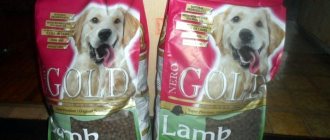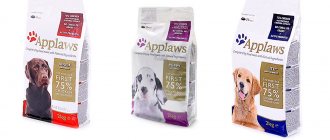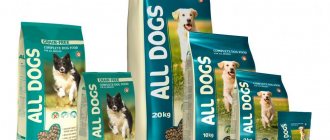You noticed that your beloved dog began to itch. It seems that you are doing everything correctly - you kill fleas regularly, get rid of worms quarterly, feed them with a nutritious diet, but everything is in vain. And external ointments do not help. Most likely your dog has a food allergy.
I will tell you how a dog is allergic to food, what signs you need to pay attention to in order to recognize an allergic reaction in time, and what to do to eliminate it.
Types of allergic reactions in animals
A dog is exposed to various irritants throughout its life. Allergies are divided according to the type of irritant and the specific course of the disease. In the second case, two types can be distinguished:
- Cumulative - the allergen accumulates gradually, the body’s reaction is slowed down, while the immune system is trying to recognize the danger and is in no hurry to take countermeasures.
- Instant - the body reacts almost immediately as soon as it encounters an irritant.
The classification by type of stimulus is much more extensive. It includes many chemical allergens and naturally occurring irritants.
- Food allergies in dogs.
Food allergies are one of the most popular and are a reaction of the dog’s body to plant or animal protein. It manifests itself during feeding. The following products in dry and natural food are particularly dangerous:
- chicken;
- dairy products;
- soy;
- wheat and corn.
The main signs of a food allergy are a rash on the face, belly and limbs; eating disorders, behavior atypical for a dog. You need to select food with caution, after consulting with your veterinarian. Feed your animal only natural ingredients, do not skimp on your pet’s nutrition.
- "Flea" dermatitis.
This is a seasonal type of allergy that can affect any pet. The reaction is not caused by the flea itself, but by its saliva, which gets into the wound and causes severe itching in the dog. An insect bite can provoke concomitant diseases, infections, fungus and worms. Dermatitis can be prevented with the help of special long-acting medications.
The main signs of flea dermatitis: dandruff (mostly black), severe itching, bruises and abrasions, loss of appetite.
Treatment is primarily aimed at destroying the allergen itself, and then at relieving inflammation and improving the condition of the pet’s skin.
- Contact dermatitis.
The reaction to it can be cumulative and instantaneous, depending on the state of the pet’s immunity. Allergies occur when there is close contact with an irritant. The allergen can be a collar, hygiene products, chemical waste or synthetic fabrics.
Main symptoms: peeling of paws, redness of the skin, blisters, pimples, itching and hair loss. To treat the pet, isolate it from the irritant, then use various ointments prescribed by the veterinarian. Sometimes your doctor may prescribe special medications that stimulate your immune system.
- Atopic dermatitis.
This is a hereditary allergic reaction that can occur due to pollen, insects, worms, various odors, chemicals, shampoos and other hygiene products. This allergy is difficult to tolerate and practically cannot be treated. The dog will have to take medication constantly to avoid relapse. The most common irritants are sun rays, perfumes, and substances on human skin.
The main causes of atopic dermatitis are genetics, ecology, climatic conditions, chronic diseases and artificial additives in products.
- Infectious allergy.
This is a type of allergy caused by an infectious disease or virus. May develop due to fungus, tuberculosis. The main signs of allergies: itching, restless behavior, redness. Antibiotics prescribed by a veterinarian are used for treatment.
- Allergic otitis media.
Otitis is an inflammation of a dog's ear (or both). It can be external, middle or internal. Characteristic signs: restless behavior, pain in the ears, sulfur discharge, unpleasant odor.
- Autoimmune.
Autoimmune allergies occur due to improper or unstable functioning of the animal's immune system, which destroys the body's own cells. Manifests itself in the form of vesicles and lupus. Autoimmune allergies can lead to the following diseases:
- vitiligo (changes in pigmentation);
- vasculitis (damage to blood vessels);
- polychondritis (damage to the cartilage near the ears).
It is treated by administering special medications on the recommendation of a veterinarian.
Why does a dog become allergic to food?
The exact causes of food allergies in dogs are difficult to determine. Allergic reactions to food are individual in nature. That is, the same ingredient can be safe for one dog and dangerous for another. An animal may be prone to allergies due to genetic predisposition or due to the abundance of the following foods in its diet:
- chocolate;
- sugar;
- fried, salted, smoked dishes.
Constant feeding of confectionery products increases the animal's sensitivity to meat products, fish, dairy products, eggs and soy products. Most often, allergies occur to chicken and cereal components.
Scientists have identified another cause of food allergies in dogs – excessive sterility of the environment. The animal's immune system must fight viruses and parasites. And because of sterility, it “remains without work” and weakens. Because of this, the pet becomes more sensitive to everything.
Prevention
As you know, any disease is much easier to prevent than to cure. This is especially true for allergies. The health of any four-legged animal often depends solely on the care of the dog.
To minimize the risk of allergic reactions, from the first days of your dog’s life you should follow simple recommendations:
- avoid eating potentially allergenic foods;
— regardless of the presence of worms, regularly carry out preventive measures related to their destruction;
- use only hypoallergenic dog cosmetics, do not use “human” products in grooming;
- do not feed the animal from your table, especially “tasty” foods, for example, smoked meats;
— inspect your dog’s ears as often as possible and clean them if necessary;
— use as little household chemicals as possible for cleaning;
— if your pet likes to dress up in his own clothes, they should be made exclusively from natural materials;
- Avoid walking in areas of actively flowering plants, which can cause allergic reactions.
Since allergies are one of the manifestations of a disorder of the immune system, vitamin complexes and immunostimulants can be used as a means of prevention.
According to recent research, dogs that received a probiotic complex as a dietary supplement from an early age were much less likely to suffer from allergic reactions.
Of course, they must be prescribed by a doctor. Proper and balanced nutrition for the animal will also help in preventing allergies. And physical activity in the fresh air will help improve your health.
Signs of food allergies in dogs
A food allergy in dogs is primarily manifested by severe skin itching. The pet begins to constantly itch (scratch everything: sides, ears, face) and lick its paws. In dogs that are heavily covered with hair, the symptoms are difficult to notice, since the ulcers and redness are hidden.
Gradually, the skin begins to turn red and pus appears. Owners mistakenly begin to treat their pets for fleas and ticks, not realizing that these are manifestations of a food allergy. It is better to take the dog to the veterinarian so that he can diagnose and determine the nature of the disease.
Basic set of warning signs:
- The fur begins to disappear in pieces, in different places.
- The bald spots are gradually growing.
- Weeping eczema appears in the armpits and folds.
- A cloying, sweetish odor appears when scratching suppurates.
Another symptom of food allergies in dogs is ear discharge. The animal constantly shakes its ears, from which a substance with an unpleasant odor is released. There is no result from medications against ticks and fleas. Improvements are observed only with anti-allergy medications.
Watery eyes appear and a viscous mass accumulates in the corners of the eye. Antibiotics can temporarily relieve symptoms. However, after their cancellation, a new round of allergies begins.
How to treat food allergies in dogs
Treatment of allergies in dogs depends on the health of the animal, the severity of the process, the presence of infection, age and other factors. It is prescribed individually, after consultation with a veterinarian. Therapy should be comprehensive and include the following activities:
- hypoallergenic diet;
- detection and elimination of allergen (irritant);
- taking medications to relieve allergy symptoms.
It is imperative to introduce dietary restrictions. If symptoms include swelling, purulent discharge, and lacrimation, the veterinarian may prescribe rinses, ointments, or drops. In case of damage to the skin or hair loss, antiseptic and antipruritic drugs are prescribed. If the dog begins to choke, you need to urgently take it to the clinic.
The veterinarian prescribes medications, selects the dose and duration of treatment. The choice of drugs is quite wide, but usually preference is given to drugs that reduce sensitivity and eliminate swelling and itching. Therapy may include agents aimed at strengthening the immune system.
Remember that only a doctor can prescribe medications. Home treatment can cause the animal’s condition to worsen.
What people write
Reviews of dog food for allergies are mostly positive. People note that their pet immediately feels better after changing their diet. Many people prefer to immediately introduce special foods into the diet from puppyhood so as not to risk the dog’s health.
There are also many positive reviews about Bosch Sensitive Lamb and Rice food. The reviews write that after prescribing it, the dog did not need a special allergy shampoo, and all symptoms disappeared.
People also note that allergies occur suddenly; owners often panic and are not prepared for such a diagnosis. After examination, veterinarians prescribe Hills food to many animals. Dogs eat it with pleasure.
Among the negative reviews, it is mentioned that the dog developed bald spots all over the body from the Acana with Lamb food.
It is worth noting that dog owners confirm that food is selected mainly “at random”. Food recommended by a veterinarian is not always suitable the first time.
How to choose dog food
Hypoallergenic food should be selected after testing. If you take the product on your own, you may make the situation worse. Take your pet to the vet. The specialist will take a skin scraping and perform a blood test.
After receiving the results, the doctor will give recommendations on the choice of food.
How to choose what to feed your dog?
- Hypoallergenic compounds should be sought only in super-premium and holistic food classes.
- Be sure to take into account the pet’s age, level of activity, and physiological condition.
- Try different foods if one doesn’t suit you and don’t look for variety if the diet is comfortable for your pet.
Elimination diet
This type of food is introduced by a veterinarian to exclude an allergenic product from the dog’s menu. In order for the animal’s body to receive all the necessary elements for normal functioning, which are contained in various types of products, it is simply impossible to exclude everything.
During the first week, poultry protein is removed from the diet, then beef, lamb, and so on until the food allergy stops. At the same time, by eliminating a certain product, the pet is monitored to see if its condition improves. When it is noted that the negative reactions have stopped or are subsiding, the last diet is fixed for another 7-10 days. If allergic manifestations have completely disappeared, the reverse process of elimination nutrition begins. Again, one by one, based on the same principle, the diet includes foods that could trigger allergies. When the pet owner identifies the suspected allergen, the dog is taken to a veterinary clinic, where specialists carry out allergic provocation. Under supervision, the animal is given to eat an allergen product that provokes a painful condition. If the signs appear again, the doctor makes an accurate diagnosis.











